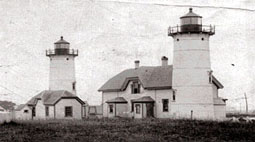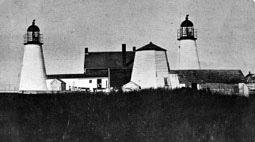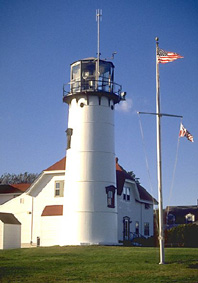|
Chatham Light

The 1841 towers
Chatham Light overlooks the gateway to Monomoy Island where seals frolic in the surf. There used to be 2 lights but now they are reduced to one. In April 1806, nine years after the construction of Cape Cod's first lighthouse in Truro, a second station was built in Chatham. The new station would have two fixed white lights to distinguish it from Highland Light. Two octagon-shaped wooden towers, each 40 feet tall and about 70 feet apart from each other, were built on moveable wooden skids about 70 feet apart. The lighting mechanism at the time was made of six lamps with and 8.5 inch reflectors, with green lenses. In 1841, the two Chatham lighthouses were taken down and re-built, as they had badly decayed. They were upgraded with fourteen-inch reflectors. A new brick dwelling was connected to both of the towers by sheltered walkways. A fierce storm in October 1841 broke 17 panes of glass in the lanterns. In 1857, the Lights received fourth-order Fresnel lenses, each showing a fixed white light and the lamps were fueled by lard oil. Another huge storm hit Cape Cod in November 1870. Before the storm, the Chatham lights were 228 feet from the edge of the 50-foot bluff. The storm had broken through the outer beaches, which hastened the erosion. By 1877 the light towers stood only 48 feet from the cliff edge. It was time to rebuild the station across the road and much farther from the edge of the cliff. Two 48-foot, cone-shaped cast-iron towers were erected in 1877, along with double 1.5-story wood-frame dwellings for the principal keeper, the assistant keeper, and their families. On September 30, 1879, the old south tower teetered precariously, only 27 inches from the edge of the cliff. Two months later, a third of the foundation now dangled over the edge. Finally, on December 15 the south tower fell to the beach below. Fifteen months later, the old keeper's house and the old north tower also followed. By the early 1900s, the Lighthouse Board began phasing out twin light stations as an unnecessary expense. The north light was moved up the coast to Eastham in 1923 to replace the survivor of the "Three Sisters." A new rotating lens was placed in the remaining tower, along with an incandescent oil-vapor lamp. In 1939, the Coast Guard electrified the light (which had been fueled by kerosene since 1882) and increased its strength as well. In 1969, the Fresnel lens and the entire lantern were removed. Modern aerobeacons producing a rotating 2.8- million-candlepower light were installed, and a new, larger lantern was built to accommodate the larger mechanism. The erosion near Chatham Light has slowed over the last few decades, but in recent years a new threat has been discovered. Hurricane Bob and the infamous "Perfect Storm" of October 1991, created a new break in the barrier beach east of the lighthouse. The parking across the street from the lighthouse was compromised by these storms. The Town of Chatham has been taking erosion control measures, but sooner or later, the Chatham Lighthouse will have to be moved or share the fate of its predecessors. Chatham Light is easy to reach by car. A right on Shore Road at the eastern end of Main Street will take you right to it. Return to Cape Cod Lighthouses from Chatham Light
|
 The light was automated in 1982. It remains an active aid to navigation, and the 1877 keeper's dwelling is used for Coast Guard housing.
The light was automated in 1982. It remains an active aid to navigation, and the 1877 keeper's dwelling is used for Coast Guard housing. 